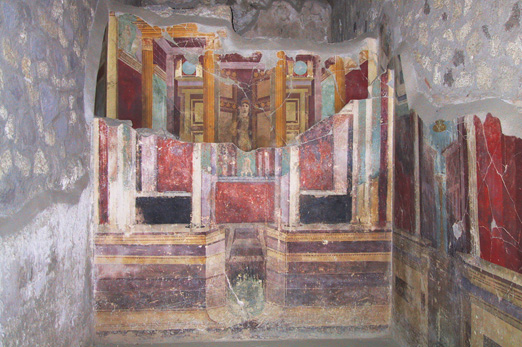 1
1Despite the presence of eschatological symbols in the Poppea atrium, such as the frieze above the door and the torch at the bottom of the same door, Steven Cerutti and L. Richardson Jr saw this wall-painting as an 'unambiguous' example of the type of tragic stage set described by Vitruvius "...for tragedy there must be columns and pediments, statues, and other royal furnishings. That is certainly what we see here, the trappings of royalty." (Cerutti & Richardson 1989 : 177) To the modern eye these 'trappings' may look like those belonging to royalty, but they were not uncommon features amongst the rich of that time and no doubt the villa containing these paintings displayed some of the architectural features and objects seen in the wall-paintings, although on a more pragmatic level. In this context the wall-paintings can be seen as a fantasized extension of the owner's dreams and aspirations, which were probably fulfilled in this particular instance when the owners daughter, or so it is thought, married the Emperor Nero.
Once again we must ask why would a wealthy person wish to reproduce a tragic stage set in a room that is commonly used to impress clients and welcome visitors? Surely themes associated with impressive lineage or living under the protection of powerful divinities would have resonated more significantly in the minds of those entering the house. An alternative way of reading the paintings as depicting propylaea leading to sanctuaries is explored in the chapter titled False-Doors. The thesis that these closed doors are there to suggest an entrance or an exit to a space that is divine, is amplified by a wall-painting in the Casa di Fabio Rufo, Pompeii (fig.1). It contains a rare depiction of a figure emerging from a closed door, who is thought to be Venus Genetrix (Aphrodite). It also contains a confusing mix of central and side doors that may indicate a compositional overlap with stage scenery, but its location in a room located deep within the house tends to negate a direct connection with the theatre. The possibility that this room functioned as a sacrarium is explored in Worshiping the House.
In conclusion the 'closed door' motif was not unique to either the ancient theatre or Romano-Campanian wall-paintings. Painted examples of this motif can also be found in Etruscan tombs in the north of Italy and therefore to use its presence as an indicator of stage scenery is problematical to say the least (fig.2). Conversely, had the wall-painting that looks on to a peristyle court in the Villa di Poppea been available to Little at the time of writing Scaenographia he may well have sighted it as a rare example of a three door 'scaenae frontes' that appears to be significantly stage-like.
 1
1
|